Related Research Articles

Nathaniel Hone was an Irish-born portrait and miniature painter, and one of the founder members of the Royal Academy in 1768.

St Stephen's Green is a garden square and public park located in the city centre of Dublin, Ireland. The current landscape of the park was designed by William Sheppard. It was officially re-opened to the public on Tuesday, 27 July 1880 by Lord Ardilaun. The square is adjacent to one of Dublin's main shopping streets, Grafton Street, and to a shopping centre named after it, while on its surrounding streets are the offices of a number of public bodies as well as a stop on one of Dublin's Luas tram lines. It is often informally called Stephen's Green. At 22 acres (8.9 ha), it is the largest of the parks in Dublin's main Georgian garden squares. Others include nearby Merrion Square and Fitzwilliam Square.

Sarah Henrietta Purser RHA was an Irish artist mainly noted for her portraiture. She was the first woman to become a full member of the Royal Hibernian Academy. She also founded and financially supported An Túr Gloine, a stained glass studio.
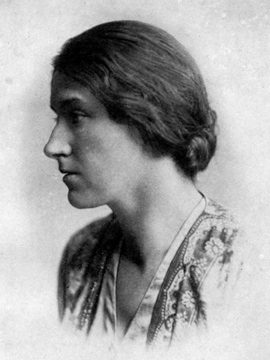
Mary Harriet "Mainie" Jellett was an Irish painter whose Decoration (1923) was among the first abstract paintings shown in Ireland when it was exhibited at the Society of Dublin Painters Group Show in 1923. She was a strong promoter and defender of modern art in her country, and her artworks are present in museums in Ireland. Her work was also part of the painting event in the art competition at the 1928 Summer Olympics.
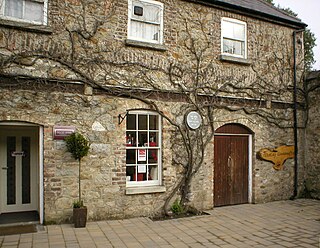
Eva Sydney Hone RHA, usually known as Evie, was an Irish painter and stained glass artist. She is considered to be an early pioneer of cubism, although her best known works are stained glass. Her most notable pieces are the East Window in the Chapel at Eton College, which depicts the Crucifixion, and My Four Green Fields, which is now in the Government Buildings in Dublin.
Four Green Fields is a 1967 folk song by Irish musician Tommy Makem, described in The New York Times as a "hallowed Irish leave-us-alone-with-our-beauty ballad." Of Makem's many compositions, it has become the most familiar, and is part of the common repertoire of Irish folk musicians.

Government Buildings is a large Edwardian building enclosing a quadrangle on Merrion Street in Dublin, Ireland, in which several key offices of the Government of Ireland are located. Among the offices of State located in the building are:
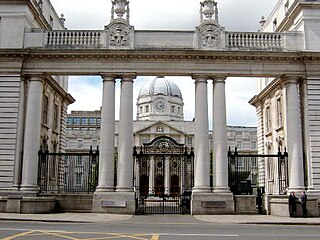
The Royal College of Science for Ireland (RCScI) was an institute for higher education in Dublin which existed from 1867 to 1926, specialising in physical sciences and applied science. It was originally based on St. Stephen's Green, moving in 1911 to a purpose-built "Royal College of Science" building on Merrion Street, now known as Government Buildings. In 1926 it was absorbed into University College Dublin (UCD) as the faculty of Science and Engineering.

The Deerfield Residence is the official residence of the United States Ambassador to Ireland in the Phoenix Park in Dublin.

Demonstration Hall is a structure on the campus of Michigan State University. It was built in 1928 with offices, classrooms, and a riding arena for the Military Science department as a replacement for the Armory. Exhibitions of agricultural stock and implements were held here, as well as athletic events. It served as the home court for the Michigan State Spartans men's basketball team from 1930 to 1940, and the ice rink for the Michigan State Spartans men's ice hockey team from 1949 until Munn Ice Arena was completed in 1974.
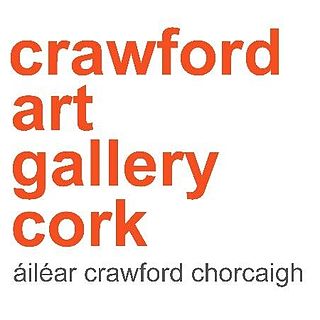
The Crawford Art Gallery is a public art gallery and museum in the city of Cork, Ireland. Known informally as the Crawford, it was designated a 'National Cultural Institution' in 2006. It is "dedicated to the visual arts, both historic and contemporary", and welcomed 265,438 visitors in 2019. The gallery is named after William Horatio Crawford.

Kingscourt, historically known as Dunaree, is a town in County Cavan, Ireland. It is located near the Cavan–Meath border. The town was founded near the site of the old village of Cabra, by Mervyn Pratt, towards the end of the 18th century, and was completed by his brother, The Rev. Joseph Pratt.
Sir Henry Augustus Robinson, 1st Baronet, was an Irish civil servant.

The Iveagh Gardens is a public park located between Clonmel Street and Upper Hatch Street, near the National Concert Hall in Dublin, Ireland. It is a national, as opposed to a municipal park, and designated as a National Historic Property. The gardens are almost completely surrounded by buildings making them less noticeable and a little hard to find, unlike other green spaces in Dublin.

The Cathedral of St. Brendan, Loughrea, is the cathedral church of the Roman Catholic Diocese of Clonfert. Though designed in neo-gothic style, it arguably houses the most extensive collection of arts and crafts and Celtic Revival artifacts of any single building in Ireland. Its most noteworthy feature is the extensive collection of stained glass windows by the Dublin-based An Túr Gloine studio. There are also twenty-four embroidered banners, mostly depicting Irish saints as well as vestments by the Dun Emer Guild. Sculptors represented are John Hughes (sculptor) and Michael Shortall, and the architect William Alphonsus Scott also contributed designs for metalwork and woodwork. The foundation stone was laid on 10 October 1897 and the structure was completed in 1902; most of the interior features date from the first decade on the twentieth century with the exception of the stained glass windows which continued to be commissioned up until the 1950s.
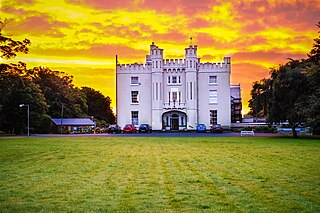
Manresa House is a retreat centre run by the Society of Jesus in the Dollymount area of Clontarf in Dublin, near Saint Anne's Park. In the 19th century it was home to Robert Warren and Arthur Guinness, and it is a protected structure.
Catherine Amelia "Kitty" O'Brien was an Irish stained glass artist, and a member and director of An Túr Gloine.
Alfred Ernest Child (1875–1939) was an English stained glass artist, a lecturer in the Dublin Metropolitan School of Art and was associated with An Túr Gloine.
Patrick Pollen was a British stained-glass artist who spent most of his life working in Ireland.
Hubert Vincent McGoldrick was a Dublin-born stained glass artist, one of a small number of Irish artists which included Michael Healy, Wilhelmina Geddes, Evie Hone, and Harry Clarke, who worked in this medium and achieved international recognition for their work in the first half of the 20th century. His career at An Túr Gloine spanned from 1920 until 1943; thereafter he produced very few works in the medium. Along with Ethel Rhind and Catherine O'Brien he was one of the artists at the studio who worked in opus-sectile mosaic, a side-line of the studio. Hubert McGoldrick was also an occasional illustrator and his most recognised illustration is the Magnificat Anima Mea Dominum created for the Legion of Mary.
References
- 1 2 "Evie Hone, 1894-1955". Past Exhibitions. Tate Britain. Archived from the original on 21 November 2007.
- ↑ "Staircase, Government buildings, Upper Merrion Street, Dublin 2". UCC. Archived from the original on 10 February 2012.
- ↑ "History of Government Buildings". Department of the Taoiseach Website. Archived from the original on 25 November 2007.